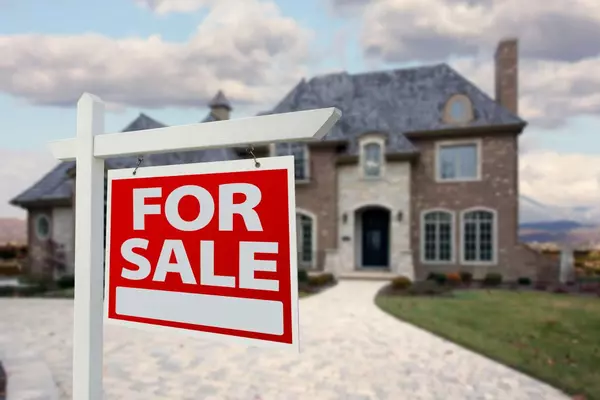
10 Tips to Selling Your Home in a Snap!
Selling your home can be an exciting but also a stressful process. If you're looking to sell your home fast, it's important to take the right steps to ensure its appeal to potential buyers. In this blog, we will delve into 10 tips for selling your home fast, covering essential areas that sellers should focus on to attract buyers and close the deal quickly. 1. Contact an agent to determine value: Before listing your home, it's crucial to get an accurate estimate of its value. Reach out to a real estate agent with experience in your area to conduct a thorough market analysis. They will consider factors like recent sales, local demand, and current market trends to help you determine the optimal listing price for your home. 2. Clean, repair, stage your home: First impressions matter, and a clean and well-maintained home will make a significant impact on potential buyers. Start by decluttering and thoroughly cleaning your home, paying close attention to areas like kitchens, bathrooms, and floors. Make necessary repairs to fix any visible issues like leaky faucets, cracked tiles, or peeling paint. Consider staging your home to enhance its appeal, using neutral colors and removing personal items to help buyers envision themselves living there. 3. Obtain professional photography: In today's digital age, high-quality photos are vital for attracting buyers online. Hiring a professional photographer who specializes in real estate will capture the best features of your home and highlight its unique qualities. These eye-catching photos will make your listing stand out, attracting more potential buyers and increasing the likelihood of a fast sale. 4. Enhance curb appeal: The exterior of your home is the first thing buyers see when they arrive, so it's essential to create a positive first impression. Boost curb appeal by tidying up the front yard, mowing the lawn, trimming bushes, and adding colorful flowers or plants. A fresh coat of paint on the front door and clean windows will further enhance the appeal of your home. 5. Market your home effectively: Creating a comprehensive marketing plan can significantly impact the speed of your home sale. In addition to listing your property on multiple online platforms, consider using social media channels and targeted advertising to reach a wider audience. Professional brochures and virtual tours can also be effective tools for showcasing your home's best features. 6. Price your home competitively: Setting the right price for your home is crucial to attracting potential buyers. Your real estate agent can help you analyze the local market and set a competitive price that reflects the value of your property. Overpricing can deter buyers, while underpricing may result in missed opportunities. Finding the right balance is key. 7. Be flexible with showings: To sell your home fast, it's important to be accommodating when it comes to showing requests. Work with your agent to establish a flexible showing schedule that allows potential buyers to view your home at their convenience. The more accessible your home is, the higher the chances of attracting serious buyers quickly. 8. Highlight unique selling points: Identify and emphasize the unique features and selling points of your home. These could include architectural details, energy-efficient upgrades, a spacious backyard, or proximity to schools, parks, or other amenities. Promote these aspects in your listing description and during showings to capture the interest of potential buyers. 9. Make necessary upgrades: Consider making cost-effective upgrades that can significantly increase the appeal and value of your home. Focus on upgrades that have a high return on investment, such as kitchen or bathroom renovations, fresh paint, modern light fixtures, or energy-efficient appliances. These improvements can make your home more enticing to buyers, potentially leading to a quicker sale. 10. Negotiate strategically: When receiving offers, it's essential to negotiate strategically to ensure a fast and favorable sale. Your real estate agent can guide you through the negotiation process, helping you evaluate offers and counteroffers effectively. By understanding the current market conditions and assessing the buyer's motivation, you can make informed decisions that will facilitate a quicker sale. Selling your home fast requires careful planning, attention to detail, and the right strategies. By following these ten tips and working closely with an experienced real estate agent, you can maximize your chances of attracting potential buyers and securing a quick sale at the best possible price.

3 Must-Haves When Listing Million-Dollar Homes
When it comes to listing million-dollar homes, there are certain aspects that sellers should consider to attract potential buyers. In this blog, we will delve into the three must-haves that can make all the difference in selling luxury properties. From showcasing the unique lifestyle these homes offer to highlighting the appeal of the neighborhood, let's explore how professional photography, comprehensive property descriptions, and strategic marketing play a crucial role in ensuring a successful sale. Professional Photography and Videography: First Impressions Matter In the digital age, where most potential buyers search for properties online, captivating visuals are the key to making a strong first impression. When it comes to million-dollar homes, professional photography and videography are an absolute must. A skilled photographer can capture the grandeur and unique features of these properties, creating images that speak directly to the desires of high-end buyers. Using high-resolution photos and videos, buyers can virtually walk through the home, appreciating the craftsmanship, design, and attention to detail that sets it apart. These visuals not only showcase the luxury elements but also highlight the lifestyle that comes with owning such a prestigious property. From capturing the breathtaking views to highlighting the high-end amenities, professional photography and videography elevate the listing's appeal and make buyers eager to see more. Comprehensive Property Description: Telling the Full Story While visually appealing imagery is essential, it should be accompanied by a comprehensive property description that tells the full story of the home. Buyers investing in million-dollar properties are looking for more than just a house – they seek an experience. An engaging description should highlight the unique features, architectural design, and exceptional finishes that make the property stand out. To craft an effective property description, it is crucial to understand the target audience. Whether it be a luxury penthouse in the heart of a bustling city or a serene waterfront mansion, the description should cater to the lifestyle aspirations of potential buyers. By emphasizing the amenities, such as a custom wine cellar, state-of-the-art home theater, or expansive outdoor entertainment area, sellers can paint a vivid picture of the luxurious lifestyle that awaits the new owner. Strategic Marketing: Reaching the Right Buyers Selling million-dollar homes requires a targeted marketing approach. It is essential to reach potential buyers who are specifically interested in high-end properties and have the financial means to invest in them. Utilizing digital platforms, such as social media, real estate websites, and email campaigns, can help reach a broad audience and create a buzz around the listing. By partnering with a knowledgeable real estate agent who specializes in luxury properties, sellers can take advantage of their extensive network and connections in the high-end market. Leveraging these networks can help ensure that the listing reaches qualified buyers who are actively looking for million-dollar properties. When listing million-dollar homes, sellers must prioritize professional photography and videography, comprehensive property descriptions, and strategic marketing. These three must-haves play a crucial role in attracting potential buyers, creating a desire for the lifestyle that these properties offer, and ensuring a successful sale. By investing in these key elements, sellers can effectively showcase the unique features of their luxury homes and appeal to the desires of high-end buyers.

Understanding the Escrow Process
When it comes to buying a home, the escrow process plays a crucial role. It acts as a neutral third party that oversees the transaction, ensuring that both the buyer and the seller fulfill their obligations. In this blog post, we will delve into the various aspects of the escrow process, from the initial deposit and escrow account to the escrow timeline and contingencies, and finally, the closing and disbursement. The Initial Deposit and Escrow Account Once an offer is accepted on a property, the buyer typically submits an initial deposit, also known as an earnest money deposit, to the escrow account. This deposit demonstrates the buyer's commitment to purchasing the property and is usually a small percentage of the total purchase price. The funds will be held in the escrow account until the closing, at which point they will be applied towards the final purchase price. The Escrow Timeline and Contingencies Once the initial deposit is made, the escrow process begins. The timeline can vary depending on various factors, such as the complexity of the transaction and the parties involved. During this period, the buyer and seller work to fulfill certain contingencies outlined in the purchase agreement. These contingencies may include obtaining financing, conducting inspections, and ensuring the property meets certain criteria. For the buyer, obtaining a mortgage is often a critical contingency. The buyer will work with their lender to complete the necessary paperwork, provide financial documentation, and undergo an appraisal of the property. It's important for the buyer to stay in close communication with their lender to ensure a smooth and timely closing. In addition to financing, the buyer may also need to satisfy other contingencies, such as conducting a home inspection. The inspection allows the buyer to identify any potential issues with the property and negotiate repairs or credits with the seller if needed. The timeframe for completing inspections and negotiating repairs should be clearly outlined in the purchase agreement. Closing and Disbursement Once all contingencies have been satisfied, the closing can take place. The closing is the final step in the escrow process and involves the signing of all necessary documents and the transfer of funds. During the closing, the buyer will pay the remaining balance of the purchase price, including any closing costs and fees. The escrow agent, who acts as a neutral party, will oversee the closing and ensure that all documents are properly executed. They will also disburse the funds to the appropriate parties, such as the seller, the real estate agents, and any other parties involved in the transaction. The length of the escrow process can vary, but it typically takes around 30 to 45 days from the time the offer is accepted to the closing. However, this timeframe can be influenced by factors such as the complexity of the transaction, the responsiveness of the parties involved, and any unforeseen issues that may arise. Understanding the escrow process is essential for both buyers and sellers in a real estate transaction. From the initial deposit and escrow account to the contingencies and the closing, each step plays a crucial role in ensuring a successful and smooth transaction. By working closely with their real estate agent and staying informed throughout the process, buyers can navigate the escrow process with confidence and achieve their dream of homeownership.
Categories
Recent Posts










